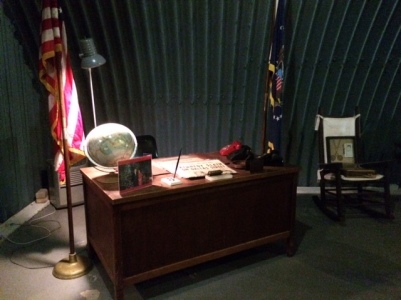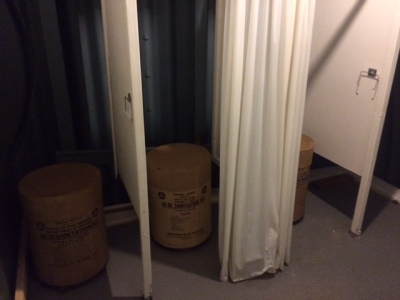As I write this, I am sitting in an airport in Fort Lauderdale when I hear an unexpected last call announcement for a flight about to depart for Cuba; the gate is closing. The announcement takes me by surprise, especially on this day, after a most memorable visit to a bomb shelter built for a president and his family in the aftermath of the failed Bay of Pigs invasion when all gates to Cuba were most definitely closed.
The Kennedy Bunker on Peanut Island in Palm Beach County, Florida

This story is about my visit to the Kennedy Bunker, an underground fallout shelter in Florida. The shelter was built in December 1961 before President John F. Kennedy’s visit to Palm Beach for a Christmas holiday with his family. It is a stark reminder of the Cold War. A sister shelter was built in Nantucket.

I put together this brief, selective, timeline of the historical events surrounding this bunker’s construction. I had to when I read that JFK gave a speech in October 1961 urging all Americans to build bomb shelters in their homes “as rapidly as possible.” Can you imagine such a speech today? There would be pandemonium amplified by a kazillion wireless communication devices.
- Cold War: approximately 1947-1991
- January 1, 1959, Cuban Dictator Batista forced out by Castro-led Soviet-supported Communist revolution.
- January 3, 1961: President Eisenhower severed diplomatic relations with Cuba.
- 1961: Commercial airline flights to Cuba ceased.
- April 17-19, 1961: The Bay of Pigs
- October 6, 1961: The President gave a speech urging all Americans to build a fallout shelter in their home because of the risk of a nuclear war with the Soviet Union.
- December 1961: Navy Seabees (the Naval Construction Force) built Kennedy bunker under the direction of the Secret Service.
- July 1962: Soviet and Cuban leaders (Khrushchev and Castro) agreed to place nuclear missiles in Cuba and construction of missile launch facilities began.
- October 14-28, 1962: The Cuban Missile Crisis
- October 28, 1962: Khrushchev orders withdrawal of missiles from Cuba
- Aug 31, 2016: Resumption of regular commercial flights to Cuba out of the U.S.
The Bunker Tour
The bunker entryway was built into the hillside and covered with twelve feet of bags of concrete mix and dirt. It was meant to be a radiation proof safe haven for the President from which JFK and his entourage could lead the country.

As I walked into the dimly lit 40-foot long corrugated steel tunnel, I was immediately struck by a twilight zoney sense of the reality of a tense time in our geopolitical history.

I had a flashback to 1962 when as a kindergartner in Baltimore, only forty miles from Washington D.C., we practiced Duck and Cover drills in the classroom.
As children, we knew, sort of, what this sign on public buildings meant.

I’ve since learned the six black and gold triangles depicted in the sign stood for shielding from radiation, food and water, trained leadership, medical supplies, communication, radiological monitoring, all focused jobs of the Office of Civil Defense.
Some of the mechanicals in this Peanut Island shelter: a generator and an air handler.


A ham radio, also known as amateur radio.

Before taking two 90-degree turns to get to the living quarters, one would do a radiation check. If you tested positive, you rinsed off in the decontamination shower before proceeding. I had a vague memory that radiation couldn’t turn corners, so entranceways to bomb shelters always include a maze of concrete walls through which to navigate. If you had a bomb shelter in your home while growing up, please tell us about it in the comments section.


The living quarters. Walking into this room blew my mind. The artifacts, some original, some not quite accurate for the time period, instantly put the gravity of the Cold War into perspective.
Note to viewers: as striking as it is, I’ve read the presidential seal on the floor was not original to this bunker.

Another view of this room from a fellow traveler, photographer Kay Ohto who kindly allowed me to use his photos for this post. Assume that all the good photos were taken by him. He understood how to shoot photos in minimal lighting.

Bunk beds and lockers for the family and entourage. Originally, there were 15 sets of bunk beds.

An army-issued desk and chair. Most of the items on the desk are not original.

Here is another view. BTW, the red phone, aka “the hotline,” is just a prop. There was a direct line between Washington and the Kremlin, but it was through a teletype. The red phone only happened in the movies.
Thinking about movies, if you want a refresher course on The Cuban Missile Crisis, watch Thirteen Days. My husband and I just watched it and literally sat on the edge of our seats throughout most of the second half. It was JFK’s finest hour.

The kitchenette with lead-lined containers of water and boxes of MRE’s, Meal Ready to Eat.

Bathroom stalls with portable plastic-lined commodes — barrels with toilet seats placed on top.

There was an escape hatch, too.


The escape tube pictured above was originally surrounded by bags of concrete similar to this cross-section of ground-fill that covered the bunker.

The President would have been flown by helicopter from his winter residence on Palm Beach Island to the helipad on this island. To get onto the island today, you need to take a water taxi, private boat, or kayak.

A map showing the location of the fallout shelter located on Nantucket Island for use when the President was vacationing in Hyannisport, MA. This bunker is not open to the public.

The Peanut Island Bunker is located in a public park. We got to the island with a very safe kayaking outfit with excellent guides, arranged for us by our hotel concierge, through The Palm Beach Maritime Museum.

There is also a decommissioned U.S. Coast Guard Station on the Island. During the Cold War, if locals asked about the bunker, they were told it was an ammunition depot for this Coast Guard station.

I’d also like to recommend a fabulous historical and cultural bike tour of Palm Beach Island with Leslie Diver of Island Living, Palm Beach. I’ve done her tour twice and have learned something new each time.
LET’S STAY CONNECTED!
Follow my photos of vegetables growing, backyard chickens hanging out, and dinner preparations on Instagram at JudysChickens.
Never miss a post: sign up to become a follower of the Blog.
© 2014-2017 Judy Wright. All rights reserved. Photos and text may only be used with written consent.


Judy, this brought back so many memories! I was a teenager when all of this history was happening. We had a bomb shelter in Winchester , Tennessee. I remember my father walking into my bedroom and telling me that if he came in the night to follow directions immediately and ask questions later. That must have been the night of October 1962. I remember because I was a junior in high school and I was studying for a test over Julius Caesar! We are going to Palm Beach in Feb. Have not made flight arrangements . Would you recommend flying into Fort Lauderdale instead of Palm Beach?
Sent from my iPad
>
Fascinating cudy
Samuel A Culotta Jr. President, Broker – Owner Platinum Group Companies, LLC
>
Thanks, bro. That’s a first! Carl sent me a nice note, too. xo
Judy, I just sent an email to you that I forwarded your blog posting to my husband……….and I could tell when he read it, as from the other end of the house I heard a loud: That was impressive!!!
I think there will be a lot of ladies sharing this one with their hubbies 🙂
Thank you for your always high-quality and always educational blog posts.
Margaret
Wow, Margaret! Thank you for the very generous and encouraging comment. Thanks for sharing the post with dear Pat, too. I am honored. xo Judy
I have lived 45 minutes from there for 30 years and never knew it was there. Have to make the trip. Thanks Judy.
They’ve actually had trouble keeping it open– maybe that’s why it is not so well advertised. xo
Love this blog. I also grew up in Baltimore, but my duck and cover was during the Suez Crisis. Other bunkers I have experienced The Greenbrier and the Churchill War Room in London!
Thanks, Anne. The Churchill War Room is exceptional, I agree. Talk about putting you into a page from the history books. I had to look up the Suez Crisis on the History.com . I didn’t remember that Crisis until you mentioned it, nor did I know it was a situation requiring Duck and Cover drills for Americans at home. BTW, on the advice of one reader, I watched “13 Days” last night. It was a good history lesson. Times have changed so much in the way information is disseminated, I know that is an understatement. Thanks for writing. Merry Christmas.
Thanks for sharing! Interesting read! I am in Palm Beach twice a year visiting my college roommate. We will have to do this!
Judi, it’s excellent. Try the bike tour, as well!
You should see the rusty metal spikes on a long rail road like iron pole along side the Cuban roads. They were afraid the US would sent airplanes to invade and land on the Highways so the spikes were there to be pulled across the roads to prevent any landings. Think both populations have some long held ideas of each other. I went on two mission trips to Cuba and found the people very likable but leery of Americans from all the propaganda against us. Beautiful country.
Thank you for writing. I hope to visit soon.
Judy! That is absolutely fascinating. I cannot wait for Jeffrey to read it. I didn’t know about the bunker. Thank you!
Sent from my iPhone
>
Thanks, Varina. It’s pretty impressive. I was thinking it should be at The Smithsonian so more people could see it and to make the props more historically accurate.
Judy, how very fascinating! Thanks for this! Can I just follow you around??? You do such cool things!
And, by the way, MY husband subscribes to your blog.
Thanks, Susie! That is so great to hear about Russell, too. Doe s he cook?